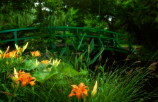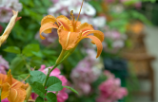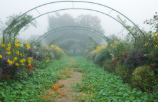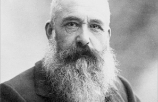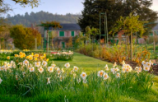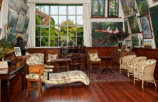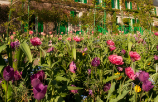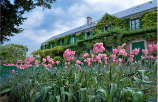Claude Monet
Timeline
Claude Monet lived in his Giverny house for 43 years, from 1883 to 1926. As passionate about gardening as he was about colours, he designed his flower and water gardens as veritable artworks. Visitors wandering around his garden and house can still experience the atmosphere that reigned when the master of impressionism lived there and can marvel at the floral compositions and water lilies that were Monet’s most fertile sources of inspiration.

Claude Monet lived in his Giverny house for 43 years, from 1883 to 1926. As passionate about gardening as he was about colours, he designed his flower and water gardens as veritable artworks. Visitors wandering around his garden and house can still experience the atmosphere that reigned when the master of impressionism lived there and can marvel at the floral compositions and water lilies that were Monet’s most fertile sources of inspiration.
1840 Oscar-Claude Monet is born in Paris, France (14 November).
1845 The Monet family moves to Le Havre.
1856-58 Initial success with caricatures; Monet meets Boudin who introduces him to painting.
1858 He sends a painting to the Le Havre municipal exhibition.
1859-60 With help from his family, Monet leaves for Paris; has contact with Troyon and the realist sphere thanks to Amand Gautier; spends time at Académie Suisse where he probably meets Pissarro.
1861-62 Military service in Algeria; returns to Le Havre and meets Jongkind in autumn.
1862-63 Spends time in the Gleyre studio in Paris where he makes friends with Bazille, Renoir and probably Sisley.
1864 Stays in Honfleur with Bazille, then with Boudin and Jongkind; problems with his family.
1865 First acceptance and first success at the Paris Salon with two landscapes; starts ‘Luncheon on the Grass’ and almost completes it by the end of the year; upon seeing the artwork, Courbet congratulates him.
1866 Leaves ‘Luncheon on the Grass’ unfinished; success at the Salon with ‘Camille (The woman with a green dress)’, enjoyed by Zola among others; meets with Manet; lives in Sèvres where he starts ‘Women in the Garden’, then moves to Honfleur.
1867 Lives with Bazille at 20 rue Visconti; rejected by the Salon; stays in Sainte-Adresse; his companion and future wife Camille Doncieux gives birth to their first child, Jean.
1868 Accepted to the Salon with one artwork; has financial difficulties and receives help from ship-owners in Le Havre, Monsieur and Madame Gaudibert; wins a silver medal at the Le Havre international maritime exhibition (October).
1869 Rejected by the Salon; stays in Saint-Michel, near Bougival, where he works with Renoir; also paints in Louveciennes alongside Pissarro.
1870 Rejected by the Salon; marries Camille Doncieux; after war is declared, takes refuge in England with his family that summer.
1870-77 Stays in London where he meets Pissarro again and meets art dealer Paul Durand-Ruel, then stays in Zaandam, Holland. Back in France, he settles down in Argenteuil in late 1871.
1872 Stays in Rouen and Le Havre; also works in Argenteuil.
1874 First impressionist exhibition where Monet notably exhibits the painting ‘Impression, Sunrise’ which gave rise to the movement’s name.
1876 Participates in the second impressionist exhibition with his Argenteuil landscapes and ‘La Japonaise’; paints decorations for Ernest and Alice Hoschedé at Château de Rottembourg in Montgeron.
1877 Paints views of Saint-Lazare Station, some of which figure in the third impressionist exhibition the same year.
1878 Has to leave Argenteuil at the start of the year and temporarily moves to 26 rue d’Edimbourg, Paris, where his second son Michel is born, before moving to Vétheuil.
1879 Exhibits 29 artworks at the fourth impressionist painting exhibition, with those artists changing their name to ‘independent artists’ (28 avénue de l’Opéra, Paris; 10 April to 11 May). Camille Monet dies (5 September).
1880 Monet capitalises on the exceptional motifs offered by the memorable breaking up of the river ice in the first few days of January to create several stunning paintings.
1881 From 17 February, Durand-Ruel becomes a regular purchaser of Monet’s works.
1882 After several days in Dieppe, moves into the hotel/restaurant ‘À la Renommée des Galettes’ in Pourville-sur-Mer
(15 February to mid-April).
1883 Spends several days in Le Havre, then Étretat (Hôtel Blanquet) (late January to 21 February).
1884 Stays in Bordighera, on the Riviera di Ponente (Italy), then Menton (January to mid-April).
1885 Exhibits for the first time at the international exhibition organised by art dealer Georges Petit (opened 15 May at 8 rue de Sèze, in Paris).
1886 Monet returns to Étretat (February) and sends ten artworks to the Les XX exhibition in Brussels (February).
1887 Exhibits at Galerie Petit’s sixth international exhibition (8 May to 8 June).
1888 Works in Antibes and Juan les Pins (mid-January to early May); lives, at the same time as the artist Harpignies, at Château de la Pinède in Antibes, a boarding house for artists, on the recommendation of Maupassant who he met in Cannes.
1889 Art critic Geffroy takes Monet, Louis Muller and Frantz Jourdain to the Creuse valley for a few days where they stay with the poet Maurice Rollinat in Fresselines (second fortnight of February).
Excited by the region, Monet returns there for a longer stay (March to mid-May).
1890 Buys the Giverny property, where he builds a new studio and makes the garden more beautiful (autumn).
1891 Exhibits 15 versions of the ‘Haystacks’ at the exhibition of Claude Monet’s recent works at Galerie Durand-Ruel (4-16 May).
1892 Durand-Ruel exhibits around 15 ‘Poplars’ paintings (29 February to 10 March).
1893 Works in Rouen again on his ‘Cathedrals’ (February to mid-April).
1894 In November, Cézanne visits Giverny where Monet introduces him to Geffroy, Rodin and Clemenceau (28 November).
1895 Travels to Norway (late January to early April).
1896 Works in Pourville-sur-Mer and Varengeville-sur-Mer (mid-February to April).
1897 Returns to the same places (mid-January to March).
1898 Georges Petit organises an exhibition of Monet’s recent artworks (opens 1 June) including ‘Mornings on the Seine’.
1899 Stays in London (autumn).
1900 Returns to London (February).
1901 A similar exhibition is presented by Durand-Ruel in New York (February).
1902 Six ‘View of Vétheuil’ artworks created by Monet in the summer of 1900 are unveiled to the public at an exhibition at Galerie Bernheim-Jeune of Pissarro’s recent artworks and a new series by Monet (‘Vétheuil’) (20-28 February).
1904 Thirty-seven ‘Views of the Thames in London’ (1900-1904) comprise the theme of a new exhibition at Galerie Durand-Ruel (9 May to 4 June).
1908 Stays in Venice (October to December).
1909 An exhibition entitled ‘Les Nymphéas, Séries de paysages d’eau’ (Water lilies, series of water landscapes) is held at Galerie Durand-Ruel
(6 May to 5 June; 48 artworks).
1911 Alice Monet dies (19 May).
1912 Galerie Bernheim-Jeune presents 29 ‘View of Venice’ (28 May to 8 June).
1914 Jean Monet, the artist’s eldest son (who married Blanche Hoschedé in June 1897), dies prematurely (10 February).
1922 The donation deed giving the ‘Water Lilies’ panels to the French State is signed (12 April), ratifying Monet’s promise to Clemenceau the day after the 1918 Armistice.
1923 Monet has a cataract operation. He first noticed issues with his eyesight in 1908 and the condition was diagnosed in 1912.
1924 Durand-Ruel exhibits ‘Water Lilies’ in New York (February).
1926 Vuillard and Roussel visit Monet at Giverny (8 June). Monet dies at the age of 86 (5 December).
1927 Official unveiling of the ‘Water Lilies Grandes Décorations’ installed at Musée de l’Orangerie as per Monet’s previously specified layout (17 May).


